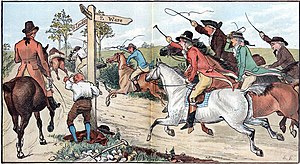Edmund Evans
He employed and collaborated with illustrators such as Walter Crane, Randolph Caldecott, Kate Greenaway and Richard Doyle to produce what are now considered to be classic children's books.
[2] Bentley soon realized the boy was talented after seeing his early attempts at scratching illustrations on slate, and arranged for Evans to begin an apprenticeship with wood-engraver Ebenezer Landells.
[4] Toward the end of his apprenticeship, the demands of the Illustrated London News caused Evans to work late into the night and return early in the morning.
During the 1860s, his most notable work was for James Doyle's A Chronicle of England,[10] which includes 80 illustrations, and is considered evidence of his capability as a master of colour.
[15] Before he began printing children's books, much of Evans' business was to provide colour printwork for magazines[17] such as Lamplighter, The Sunday School Companion and Chatterbox.
[18] With increased print orders, Evans leased space on Fleet Street to expand the business, adding steam engines, boilers and "many extra machines".
In the 1860s, Thomas Bolton developed a method for transferring a photographic image onto block, which enabled the engraver "to work on the surface".
[16] His work was distinctive because of the characteristic quality of the wood engraving (carving) and his manner of limiting the use of ink to create a more striking result.
[30] Proofs of the key block were coloured by the illustrator; Evans would then "determine the sequencing and register ... to arrive at a close reproduction of the artist's original".
[33] The chief problem was to maintain correct register, achieved by placing small holes in precise positions on each block to which the paper was pinned.
After the 1860s, images could be photographically projected onto the blocks, although it was more difficult for the printer to carve the reliefs without leaving the distinctive lines of the illustration.
[15] Evans reacted against crudely coloured children's book illustrations, which he believed could be beautiful and inexpensive if the print run was large enough to maintain the costs.
[43] The following year, Crane was given a set of Japanese prints and, impressed with "the definite black outline, the flat brilliance as well as delicate colours" he applied the techniques to toy book illustrations.
[38] During these years Crane and Evans worked for the publishing house Routledge and collaborated on books such as The Yellow Dwarf, Beauty and the Beast, Princess Belle – etoile, and Goody Two Shoes.
[23] Evans added more hues to the illustrations, with "light blues, yellows, and brick reds, delicately blended" replacing the brighter colours of earlier work.
[48] In 1880, Crane illustrated and Evans printed, The Baby's Bouquet: a Fresh Bunch of Old Rhymes and Tunes, which went on to sell hundreds of thousands of copies.
[49] Their later collaborations includes an edition of Alice in Wonderland with coloured versions of John Tenniel's 1890 illustrations, and the 1899 A Floral Fantasy in an Old English Garden.
The pressure of such steady production caused Crane to stop his work for a period, and Evans replaced him with Randolph Caldecott, whose magazine illustrations he had seen and liked.
[50] Initially Evans hired Caldecott to draw illustrations for nursery rhyme books,[51] beginning with another printing of The House that Jack Built in 1877.
[57] In the late 1870s, Kate Greenaway—who spent her earlier career illustrating greeting cards—persuaded her father, also in the engraving business, to show Evans her poetry manuscript, Under the Window.
[62] Published in 1879, Evans produced 100,000 copies of Under the Window (including French and German editions) which helped launch Greenaway's career as an author and illustrator of children's books.
[61] Evans photographed Greenaway's drawings to wood, engraved in facsimile, and created colour blocks of red, blue, yellow and flesh tint.
The "antique look" added to the Regency style artwork, while his ink and colouring choices conveyed the look of a hand-coloured book suitable for a mass-market edition.
[69] In 1902 he used the "recently developed Hentschel three-colour process", at Beatrix Potter's request, to print her watercolour illustrations for her first book, The Tale of Peter Rabbit.
[49] Towards the end of his career, not all of his work was devoted to the three-colour process; in 1902 he engraved and printed Old English Songs and Dances for W. Graham Robertson, which was described as "harmonious" and "delicate".
[70] In 1892, Evans moved to Ventnor on the Isle of Wight, and turned the printing business over to his sons Wilfred and Herbert, although when he stopped engraving wood is unknown.
[71] In that book Evans includes few details of his business practices and processes, and is significant because it adds to the scant information available on the colour printers of the era.
[57] In the 1960s, Ruari McLean edited the unrevised 102-page typescript released to him by Evans' grandson which was published by the Oxford University Press in 1967.
[1] Before his death Evans offered Beatrix Potter an interest in the company which she refused, having recently bought a farm in the Lake District.
[72] A substantial number of Evans' original engraved wooden blocks are held at the St Bride Printing Library in London.









